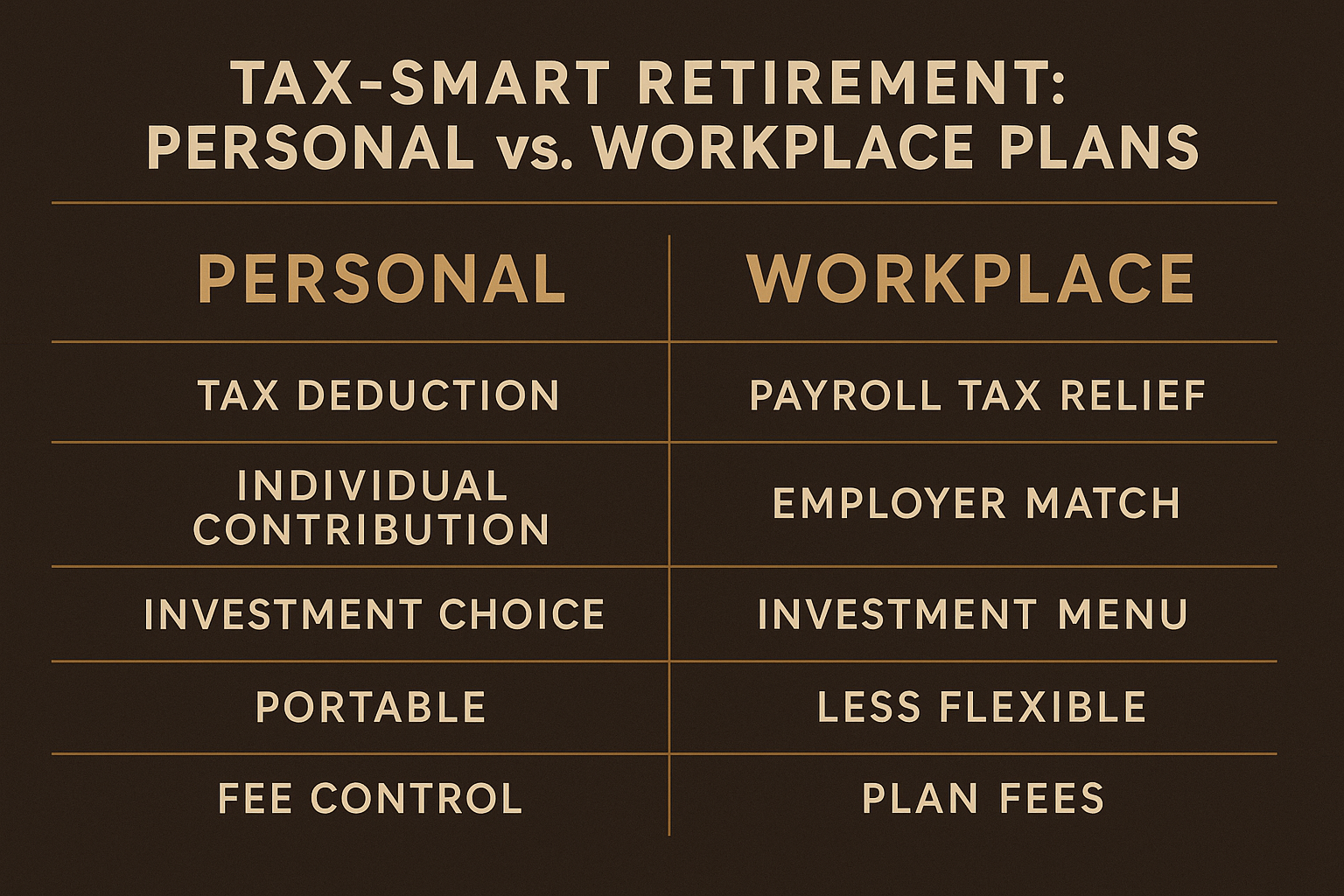Tax-smart retirement planning isn’t about choosing between a personal or workplace account—it’s about using both to minimize taxes and maximize long-term flexibility.
Quick Primer: Two Levers, One Outcome
To both save tax now and fund retirement, you usually combine:
- a workplace plan (employer pension/retirement plan; often with employer matching or contributions), and
- a personal account (individual IRA/SIPP/RRSP/etc. with broader investment choice and portability).
General order of operations (applies in most countries):
(1) Grab the employer match first → (2) Pay off high-interest debt → (3) Max out personal tax-advantaged account → (4) Add extra to workplace plan → (5) Use taxable/brokerage for flexibility.
Adjust for your tax rate, job benefits, and investment options.

How Tax Advantages Usually Work
- Pre-tax/Tax-deferred (EET): You get tax relief now; growth compounds tax-deferred; withdrawals in retirement are taxed as income.
- Post-tax/Tax-free (TEE/Roth/TFSA-style): No deduction now; growth and qualified withdrawals are tax-free.
- Employer money: Many workplace plans add employer match or contributions—free return you shouldn’t leave on the table.
- Investment menu: Workplace menus can be limited/fee-heavy; personal accounts often allow broader, lower-cost ETFs/funds.
- Withdrawals: Early withdrawals can trigger penalties/taxes; each country has its own rules and ages.
- Fees: Lower ongoing fees mean more compounding; always compare all-in expense ratios and admin fees.
Note: Limits, ages, and deduction rules change. Always check the latest official guidance in your country.
Country Playbooks
United States — IRA (personal) vs 401(k)/403(b) (workplace)
- Workplace plan:
- Pros: Employer match; high contribution limit; payroll automation; optional Roth and after-tax features; loan provisions in some plans.
- Cons: Investment menu may be narrow; plan-level fees vary.
- Personal plan (Traditional/Roth IRA):
- Pros: Broad investment choice; low-cost ETF access; Roth IRA provides tax-free qualified withdrawals and no lifetime RMDs.
- Cons: Lower annual limit; income phase-outs for deductibility/Roth eligibility.
US decision rule of thumb
- Contribute enough to 401(k)/403(b) to get full match.
- Fund Roth IRA or Traditional IRA (based on current vs expected future tax rate).
- Return to workplace plan up to annual limit.
- Use taxable brokerage for extra savings and flexibility.
Who benefits most
- High tax bracket now → pre-tax 401(k)/Traditional IRA often efficient.
- Expect higher tax later or want flexibility → Roth options (IRA or workplace Roth) add tax diversification.
- Job hoppers/DIY investors → IRAs for portability and choice.
United Kingdom — SIPP (personal) vs Workplace Pension (auto-enrolment)
- Workplace pension:
- Pros: Employer contributions; automatic enrolment; tax relief via payroll; default funds keep it simple.
- Cons: Default funds/charges vary; limited choice in some schemes.
- SIPP (Self-Invested Personal Pension):
- Pros: Broad investment choice; tax relief at your marginal rate; full control over providers and fees.
- Cons: Requires self-management; watch platform/transaction costs.
UK decision rule of thumb
- Contribute to the workplace pension at least to capture full employer contributions.
- Use a SIPP for extra saving, consolidating old pots, or accessing lower-cost trackers.
- Consider ISA alongside pensions for tax-free flexibility (no withdrawal age restrictions).
Who benefits most
- Employees with generous employer contributions → workplace first.
- Contractors/freelancers or fee-sensitive investors → SIPP control + low-fee index ETFs.
- Higher-rate taxpayers → pension tax relief can be powerful (mind annual/tapered allowances).
Canada — RRSP (personal) vs Group RRSP/Pension (workplace) + TFSA
- Workplace plan (Group RRSP/RPP/DC pension):
- Pros: Employer match/contributions; payroll deduction; sometimes institutional funds.
- Cons: Menu/fees vary; less control when changing jobs (transfer options exist).
- RRSP (personal):
- Pros: Tax-deductible contributions; broad investment choice; can convert to RRIF later.
- Cons: Withdrawals taxed as income; contribution room tied to earned income.
- TFSA (complement):
- Tax-free growth and withdrawals; perfect for flexibility/medium-term goals.
Canada decision rule of thumb
- Capture workplace match.
- Use RRSP for tax deferral if you’re in a higher bracket now than later.
- Use TFSA to build tax-free, penalty-free flexibility (pairs well with RRSP).
- Extra? Back to workplace plan or taxable account.
Australia — Personal Super Contributions vs Employer Superannuation
- Employer super:
- Pros: Compulsory employer contributions; salary-sacrifice options; generally low-cost default MySuper funds.
- Cons: Default investment may not match your risk profile; review fees and insurance premiums.
- Personal (concessional/non-concessional) contributions:
- Pros: Potential tax advantages; control of contribution timing; ability to pick competitive funds/industry supers.
- Cons: Annual caps; preservation rules restrict early access.
Australia decision rule of thumb
- Ensure employer super is paid and the fund choice suits your risk/fee needs.
- Consider salary sacrificing (concessional) to lower taxable income if within caps.
- Add non-concessional for faster compounding if you’ve maxed concessional caps.
- Keep an emergency buffer outside super—access is restricted until preservation age conditions are met.
Singapore — SRS (personal) vs CPF (workplace-linked national system)
- CPF (Ordinary/Special/Medisave; CPF LIFE for retirement income):
- Pros: Mandatory employer/employee contributions; stable base for retirement and healthcare; risk-managed.
- Cons: Limited investment choice; locked for long-term purposes.
- SRS (Supplementary Retirement Scheme):
- Pros: Tax deferral on contributions (subject to caps); broad investment menu (funds, ETFs, etc.); complements CPF.
- Cons: Withdrawal rules/penalties before statutory retirement age; investment risk is on you.
Singapore decision rule of thumb
- Treat CPF as your guaranteed core.
- Use SRS to reduce current taxable income and invest for higher expected returns.
- Keep liquid savings outside SRS for short-term needs.
Side-by-Side Snapshot (Conceptual)
| Feature | Personal Account (IRA/SIPP/RRSP/SRS/etc.) | Workplace Plan (401k/Workplace Pension/Group RRSP/Super/CPF) |
|---|---|---|
| Tax benefit timing | Often deduction/relief now (or Roth/TFSA-style later) | Payroll relief + employer money |
| Employer match | No | Frequently yes (major advantage) |
| Investment choice | Broad, DIY, low-cost ETFs possible | Menu varies; sometimes limited |
| Fees | You control provider/ETF costs | Plan admin + fund fees; compare |
| Portability | High across jobs/providers | Transfer/consolidation rules apply |
| Early access | Typically restricted/penalized | Typically restricted/penalized |
Practical Flowcharts (Text Version)
If you are an employee with a match
→ Contribute to workplace plan up to full match → Open/fund a personal account (IRA/SIPP/RRSP/SRS) → Return to workplace up to annual limit → Build taxable flexibility.
If you are self-employed/freelance
→ Open a suitable personal retirement account (country-specific) → If eligible, set up a self-employed/workplace-equivalent plan → Prioritize accounts with the best tax relief and lowest fees.
If you expect higher taxes later
→ Emphasize Roth/TFSA-like options (tax-free withdrawals) for diversification.
If cash flow is tight
→ At minimum, capture employer match (it’s an instant, risk-free return) and automate small contributions to personal account.

Portfolio & Risk Guidelines
- Glidepath: More equities when young; gradually add bonds/defensives as retirement nears.
- Costs matter: Prefer broad, low-fee index funds/ETFs; every 0.50% you save compounding over decades is meaningful.
- Rebalance: Annually or when allocations drift 5–10 percentage points.
- Tax diversification: Mix pre-tax and post-tax (Roth/TFSA-style) buckets to control future tax bills.
- Emergency fund: Keep 3–6 months’ expenses outside retirement wrappers.
Worked Example (Simple Math)
- You contribute $10,000 to a pre-tax/workplace plan at a 24% marginal tax rate → immediate $2,400 tax saved (or deferred).
- An employer match of 4% on salary (say $3,000) adds $3,000 you wouldn’t otherwise receive.
- Invested at a hypothetical 6% annual return for 25 years, the combined contributions compound dramatically—while your present-day tax bill is lower.
(Illustrative only; not a guarantee of returns.)
Compliance & When to Get Advice
- Rules (ages, caps, relief, penalties) change.
- Complex cases—high earners, business owners, cross-border moves, stock options—should consult a licensed adviser in their jurisdiction.
- Always verify current contribution limits and tax policies via official sites.
TL;DR
- Don’t choose one; coordinate both. Take the workplace plan for free employer money and tax relief, and a personal account for control, low fees, and flexibility.
- Sequence: Match → Personal account → More workplace → Taxable.
- Keep fees low, diversify, rebalance, and maintain a cash buffer.
CTA ideas (monetization-friendly, edit to your affiliate partners)
Portfolio templates (global stock/bond ETF mixes) for different risk levels.
Build a retirement plan in 15 minutes: compare low-fee brokers and robo-advisors.
Best books on tax-smart investing and retirement drawdown strategies.
FAQ
Q: Should I pick a personal or workplace retirement plan first?
A: Start with the workplace plan to capture employer match, then add a personal account for control and low fees.
Q: How do tax-smart retirement strategies work globally?
A: They combine tax relief today with tax-free growth or withdrawals later, depending on each country’s rules.
- 2025 MAMA AWARDS — Complete Lineup, Categories & What’s New from Hong Kong
- 2025 K-Beauty Trends: Mirror Skin & PDRN Skincare Revolution
- Advanced Korean Skincare Routine (2025): Night & Anti-Aging Care
- Korean Skincare Layering (2025): Intermediate Routine & Hydration Tips for Glowing Skin
- Fix “Indexing Quota Exceeded” in Google Search Console (2025 Guide)
